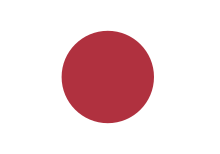
The Empire of Japan, also referred to as the Japanese Empire, Imperial Japan, or simply Japan, was the Japanese nation-state that existed from the Meiji Restoration in 1868 until the enactment of the reformed Constitution of Japan in 1947. From 29 August 1910 until 2 September 1945, it administered the naichi and the gaichi. The South Seas Mandate was a single Japanese dependent territory in the name of the League of Nations under Japanese administration. In the closing stages of World War II, with Japan defeated alongside the rest of the Axis, the formalized Japanese Instrument of Surrender was issued in compliance with the Potsdam Declaration of the victorious Allies, and Japanese de facto territory subsequently shrunk to cover only the Japanese archipelago as it is today.

The Imperial Japanese Navy was the navy of the Empire of Japan from 1868 to 1945, when it was dissolved following Japan's surrender in World War II. The Japan Maritime Self-Defense Force (JMSDF) was formed between 1952 and 1954 after the dissolution of the IJN.
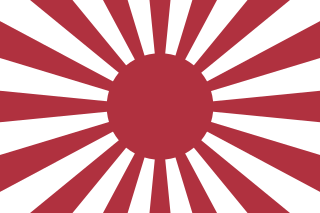
The Imperial Japanese Army (IJA) was the principal ground force of the Empire of Japan. Forming one of the military branches of the Imperial Japanese Armed Forces (IJAF), it was controlled by the Imperial Japanese Army General Staff Office and the Army Ministry, both of which were nominally subordinate to the Emperor of Japan, the supreme commander of IJAF. During the 20th century, an Inspectorate General of Aviation became the third agency with oversight of the IJA. At its height, the IJA was one of the most influential factions in the politics of Japan.
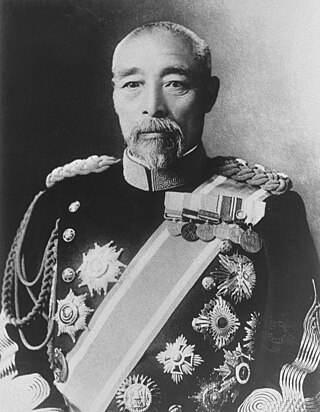
CountOku Yasukata was a Japanese field marshal and leading figure in the early Imperial Japanese Army.
This article is concerned with the events that preceded World War II in Asia.

Japanese militarism was the ideology in the Empire of Japan which advocated the belief that militarism should dominate the political and social life of the nation, and the belief that the strength of the military is equal to the strength of a nation. It was most prominent from the start of conscription after the Meiji Restoration until the Japanese defeat in World War II, roughly 1873 to 1945. Since then, pacifism has been enshrined in the postwar Constitution of Japan as one of its key tenets.
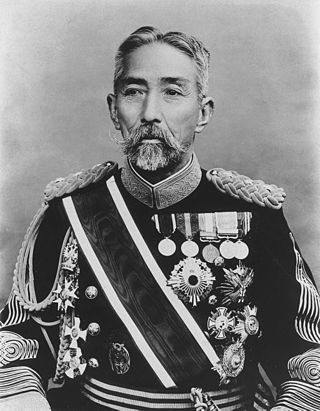
Field Marshal The Marquis Nozu Michitsura was a Japanese field marshal and leading figure in the early Imperial Japanese Army.

The Battle of Hakodate was fought in Japan from December 4, 1868 to June 27, 1869, between the remnants of the Tokugawa shogunate army, consolidated into the armed forces of the rebel Ezo Republic, and the armies of the newly formed Imperial government. It was the last stage of the Boshin War, and occurred around Hakodate in the northern Japanese island of Hokkaidō. In Japanese, it is also known as the Battle of Goryokaku

Marshal Admiral BaronIjūin Gorō was a Meiji-period career officer in the Imperial Japanese Navy.

CountKabayama Sukenori was a Japanese samurai military leader and statesman. He was a general in the Imperial Japanese Army and an admiral in the Imperial Japanese Navy. He later became the first Japanese Governor-General of Taiwan during the island's period as a Japanese colony. He is also sometimes referred to as Kabayama Motonori.
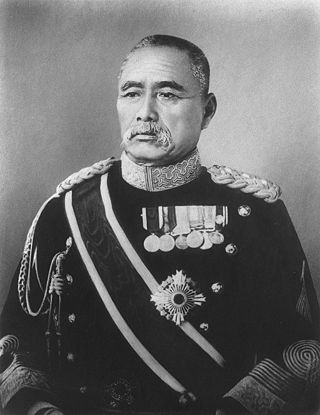
General Count Sakuma Samata was a general in the Imperial Japanese Army, and 5th Governor-General of Taiwan from 11 April 1906 to May 1915. He participated in domestic conflicts, wars with Russia and was a leader of the expedition of Taiwan.

Baron Tatsumi Naofumi was a samurai from the Kuwana Domain in the Bakumatsu period Tokugawa shogunate and later a general in the Imperial Japanese Army during the Meiji period.
Below is the order of battle for the Battle of Beiping-Tianjin, called the Peiking-Tientsin Operation in pinyin spelling, a series of battles fought from 25 July through 31 July 1937 as part of the Second Sino-Japanese War. It was called the North China Incident by the Japanese.
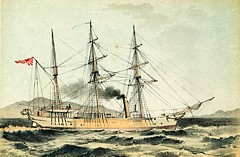
Hōshō was a screw sloop, originally built in the United Kingdom for Chōshū Domain in western Japan, and subsequently served in the early Imperial Japanese Navy.

ViscountTakashima Tomonosuke was a samurai of Satsuma Domain, general in the early Imperial Japanese Army, and a cabinet minister in Meiji period Japan. Part of Sophia University in Tokyo is located on the site of his house.
Military Medal of Honor was a military decoration for meritorious service to the Empire of Japan, formerly awarded to all military personnel who participated in battles in a war. These war medals and accompanying certificates specifically identify the conflict for which the decoration will have been awarded.

Viscount Ōshima Yoshimasa was a general in the early Imperial Japanese Army during the First Sino-Japanese War and the Russo-Japanese War. His great-great-grandson, Shinzō Abe was Prime Minister of Japan.

Ōdera Yasuzumi was a general in the early Imperial Japanese Army, and the highest ranking casualty on the Japanese side in the First Sino-Japanese War.

Viscount Nishi Kanjirō was a career soldier in the early Imperial Japanese Army, serving during the Russo-Japanese War.
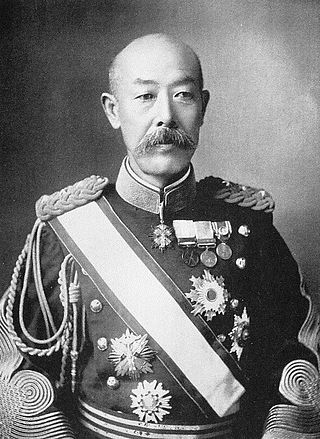
Baron Ueda Arisawa was a general in the early Imperial Japanese Army.
